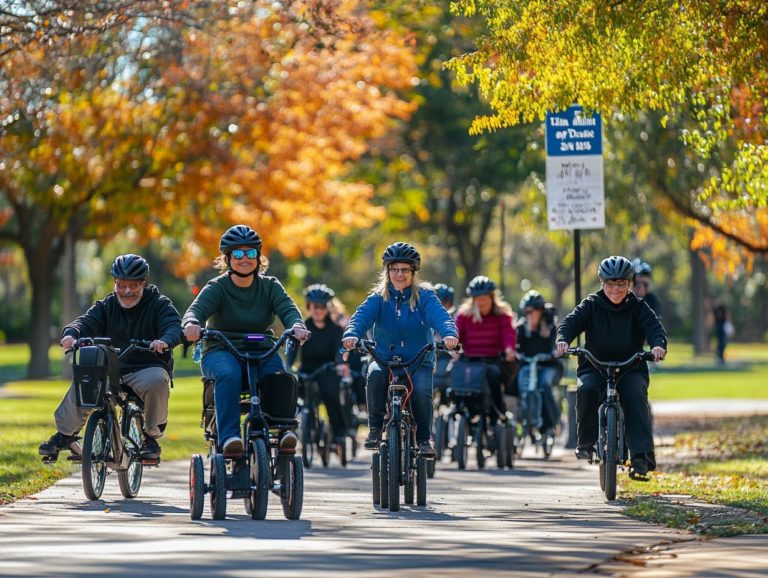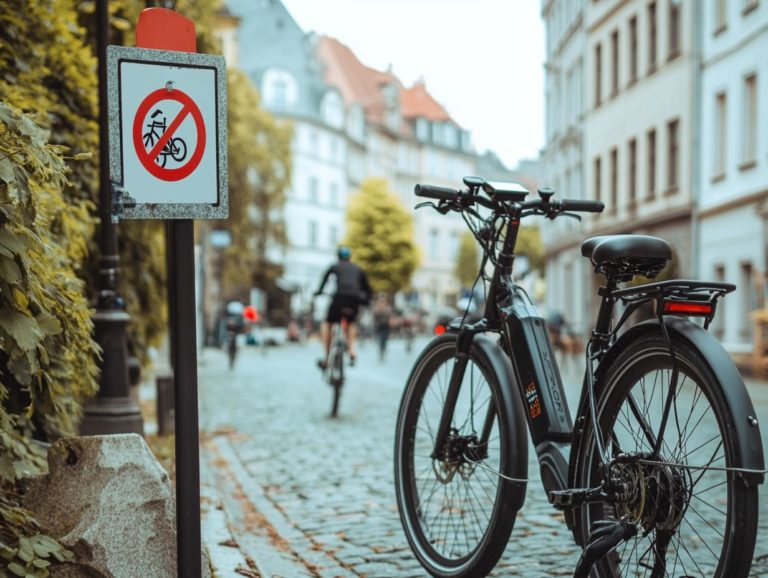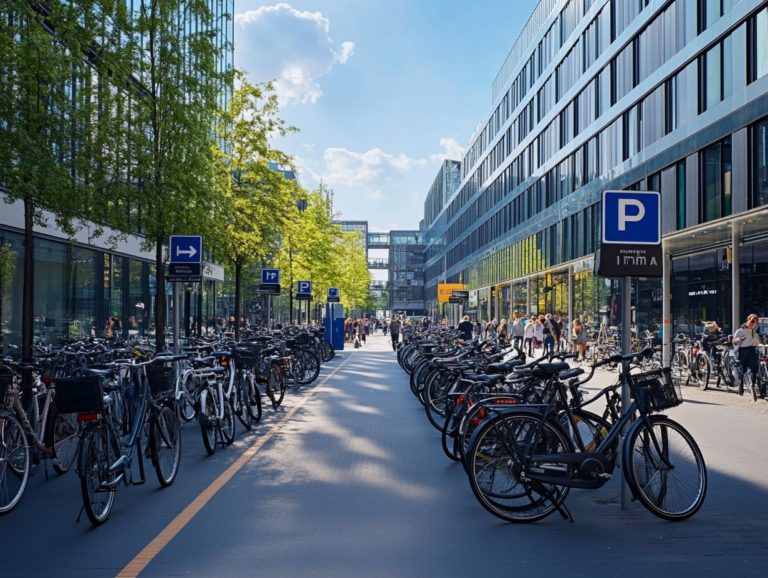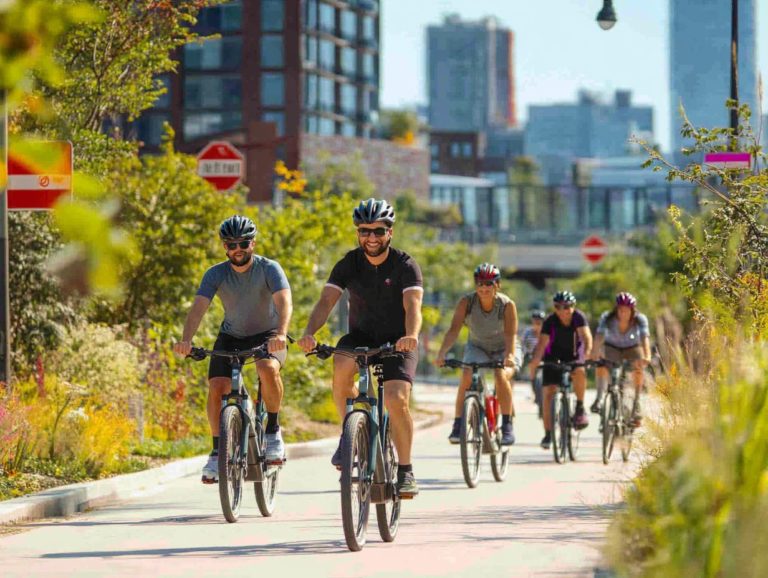Electric Bicycle Regulations in Urban Areas
Electric bicycles are revolutionizing urban transportation, presenting you with eco-friendly alternatives to traditional commuting methods. As their popularity continues to rise, so too do the regulations that govern their use. Join us as we dive into how electric bicycles are changing the cities we live in!
This article delves into the current landscape of electric bicycle regulations in major cities, showcasing various types of rules and illustrating how different urban areas are adapting to this trend. It also examines the many benefits of electric bikes, the challenges associated with enforcing regulations, and what the future may hold for this dynamic mode of transport.
Immerse yourself in this exploration to discover how electric bicycles are shaping the cities of today and tomorrow.
Contents
- Key Takeaways:
- Current Regulations in Urban Areas
- Potential Benefits of Electric Bicycles
- Challenges in Implementing Regulations
- Future Outlook for Electric Bicycle Regulations
- Frequently Asked Questions
- What are electric bicycle regulations in urban areas?
- What is the difference between electric bicycles and regular bicycles?
- Do electric bicycles need to be registered and licensed in urban areas?
- Are there age restrictions for riding electric bicycles in urban areas?
- Are there speed limits for electric bicycles in urban areas?
- Do electric bicycles need to follow the same traffic laws as regular bicycles in urban areas?
Key Takeaways:

- Electric bicycles are a growing mode of transportation in urban areas, but regulations vary by city.
- Regulations can control speed, power, and locations for electric bicycles, with cities like New York City and San Francisco having strict rules.
- Electric bicycles offer potential benefits like reducing air pollution and promoting physical activity, but challenges like enforcement and compliance must be addressed for effective regulations.
What are Electric Bicycles?
Electric bicycles, or e-bikes as they re commonly known, represent a remarkable fusion of traditional cycling and electric assistance. This combination elevates your commuting experience to new heights of convenience and efficiency.
These vehicles come in various designs, from lightweight models perfect for navigating urban landscapes to strong mountain bikes that can conquer challenging off-road trails. With options spanning Class 1, Class 2, and Class 3, each e-bike class delivers unique functionalities, enabling you to select the motor power and assistance level that aligns perfectly with your lifestyle.
If you re an urban rider, you might find yourself drawn to e-bikes boasting integrated lights and sturdy frames. These features make daily commutes seamless and allow you to glide effortlessly through city traffic. On the other hand, if adventure calls, outdoor enthusiasts like you could opt for the rugged durability and advanced features of off-road e-bikes, enhancing your journey as you tackle rugged terrains.
This impressive versatility not only meets various cycling preferences but also solidifies the role of electric bicycles as a sustainable alternative, playing a significant part in reducing urban pollution.
Current Regulations in Urban Areas
As electric bikes gain traction in urban environments, a range of regulations is being introduced to promote safety and responsible usage, especially in states like Oregon where e-bike laws are continuously evolving.
These regulations typically encompass specific speed limits based on e-bike classifications Class 1, Class 2, and Class 3 along with age restrictions for riders, helmet mandates, and registration requirements.
Across Oregon and other areas, cities are considering guidelines on where e-bikes can be ridden, such as designated bike paths and trails, all aimed at fostering safe and enjoyable riding experiences.
Types of Regulations
There are several regulations governing electric bicycles, categorized primarily by eBike classes: Class 1, Class 2, and Class 3. Each class has its own specifications regarding motor power, speed limits, and assistance features. Understanding these distinctions is essential for you to ensure compliance and fully enjoy the perks of electric biking.
Class 1 eBikes equip you with pedal-assist systems, a system that helps you pedal, that kick in only when you’re pedaling, and they cap out at a speed of 20 mph. Class 2 eBikes provide the luxury of a throttle option, allowing you to reach the same maximum speed without needing to pedal. Then there s Class 3 eBikes, which are becoming increasingly popular in urban settings they can support speeds up to 28 mph and often require you to wear a helmet.
These specific regulations can vary by state or locality, making it all the more crucial for you to grasp your regional laws. Staying informed helps you avoid penalties while enjoying the ride.
Ready to pedal into the future? Explore e-bikes today!
Examples of Regulations in Major Cities
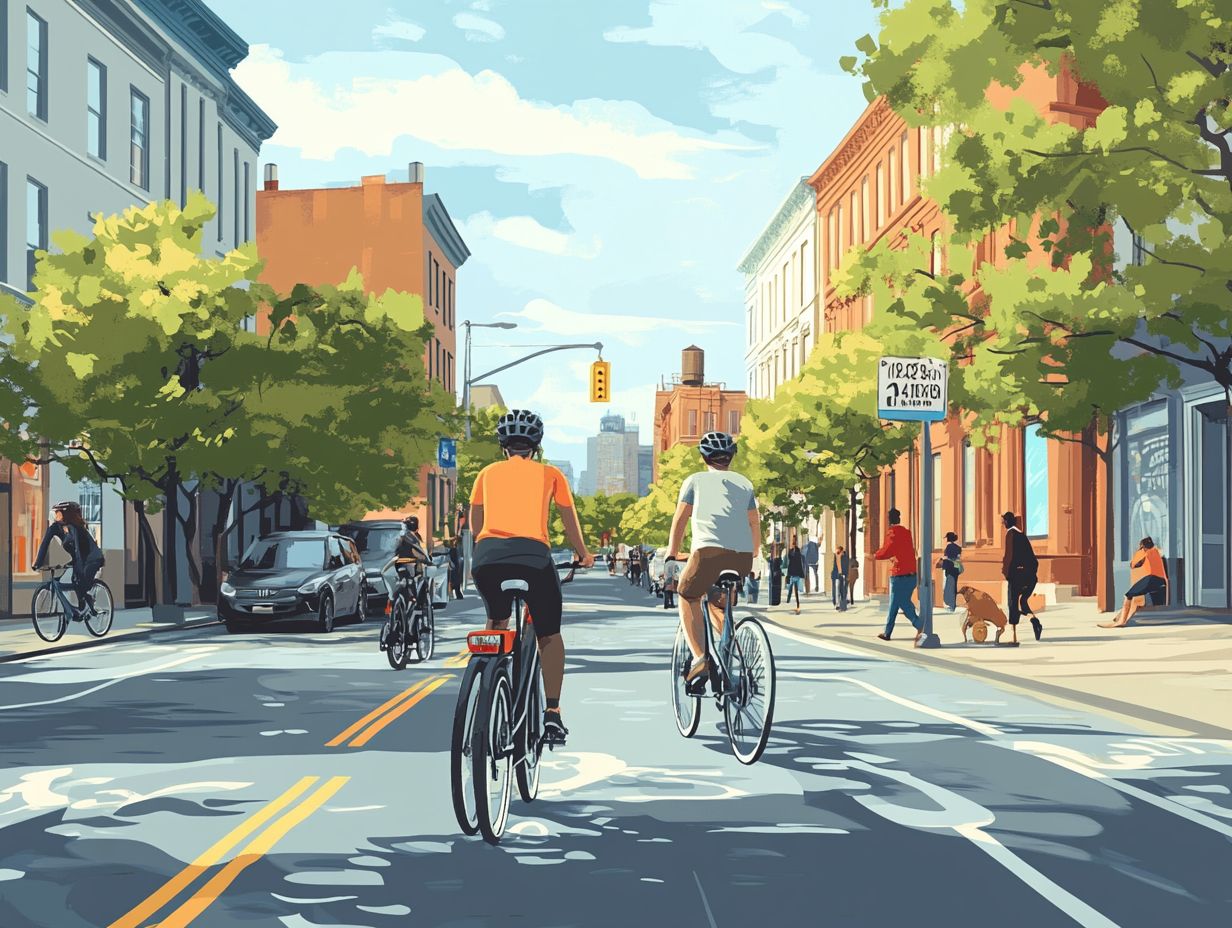
Major cities across the United States are rolling out different eBike rules tailored to local needs and concerns. Oregon cities are leading the charge, establishing comprehensive frameworks for eBike use. You ll find specific speed limits designated for each eBike class, and some places require you to register your eBike. Additionally, designated paths enhance rider safety and community acceptance. Each city s approach to these regulations uniquely shapes your riding experience and impacts the adoption of these eco-friendly vehicles.
In Portland, for instance, you’ll need to stick to a speed limit of 20 mph on public paths. Some areas restrict eBikes to designated bike lanes only. On the flip side, cities like Eugene have taken a more relaxed approach, permitting eBike operation on multi-use paths without stringent registration requirements. To learn more about regulations around the world, check out electric bicycle regulations: a global overview.
These varying regulations not only emphasize safety but also work to integrate eBikes into the existing transportation ecosystem. This encourages you to embrace a cleaner alternative. In Bend, the regulations even consider scenic routes, promoting eBike use in tourist-friendly zones and highlighting the potential for sustainable urban mobility.
Potential Benefits of Electric Bicycles
Electric bicycles present a wealth of advantages, making them an enticing option for both leisurely rides and daily commutes. One standout benefit is their eco-friendly design; they generate zero emissions, playing a crucial role in alleviating urban traffic congestion and reducing pollution.
E-bikes encourage an active lifestyle by motivating you to cycle along scenic trails and embark on outdoor adventures. This not only enhances your cardiovascular fitness but also promotes overall well-being.
Environmental and Health Benefits
The environmental benefits of electric bikes are significant, leading to cleaner air and a noticeable reduction in carbon emissions. By choosing e-bikes over traditional gas-powered vehicles, you can greatly diminish your carbon footprint and champion eco-friendly transportation alternatives.
Imagine cruising down scenic trails on an e-bike! You can immerse yourself in nature while engaging in low-impact exercise, which promotes both mental clarity and physical health.
Recent studies reveal that swapping car trips for e-bike rides can cut greenhouse gas emissions by nearly 50%, showcasing a clear and positive impact on air quality. Regular e-bike users can burn up to 500 calories per hour, translating into substantial cardiovascular benefits. In fact, a survey indicates that almost 60% of e-bike riders report feeling healthier and more active since incorporating e-biking into their lifestyle.
By embracing electric bicycles, you not only play a part in creating a cleaner environment but also enhance your physical fitness in a truly sustainable way.
Challenges in Implementing Regulations
Despite the increasing popularity of electric bicycles, you ll find that implementing regulations comes with its own set of challenges that can undermine their effectiveness and acceptance.
In places like Oregon, e-bike regulations often grapple with enforcement issues. Local authorities may not have the necessary resources or clarity to ensure compliance effectively. Additionally, differing interpretations of laws can leave riders feeling confused, which diminishes the potential benefits of these eco-friendly transportation options.
We need to find the right balance between promoting innovation and ensuring safety on the roads.
Ready to make a difference? Grab an e-bike and hit the road!
Enforcement and Compliance Issues
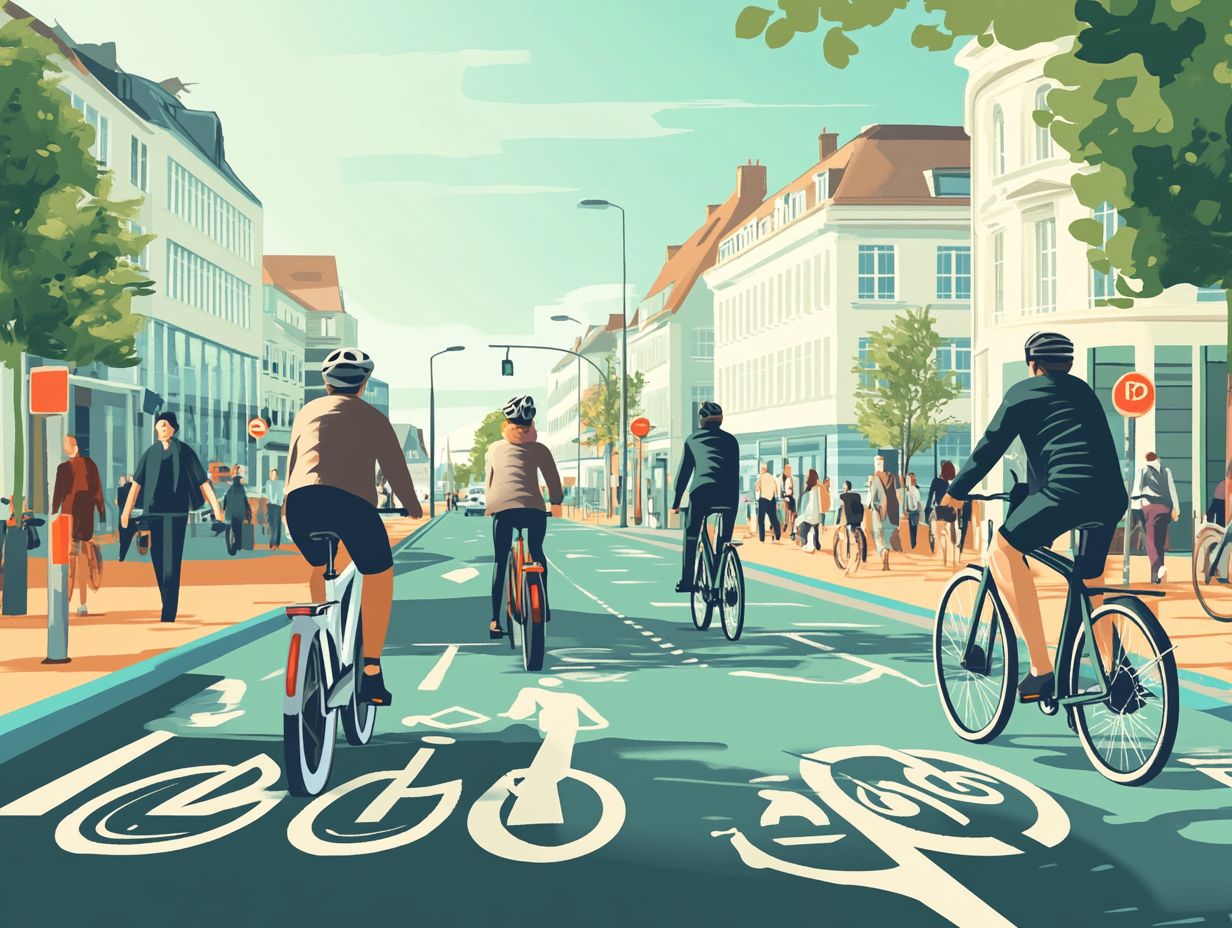
Enforcement and compliance issues surrounding eBike regulations pose significant challenges in ensuring that riders adhere to safety and legal standards. In many jurisdictions, especially in Oregon, there are hurdles in effectively policing eBike use. This leads to a lack of compliance with important regulations such as speed limits and registration requirements, raising safety concerns for both eBike riders and traditional cyclists. There is an urgent need for clearer guidelines and more robust enforcement measures.
As eBike popularity continues to rise, these challenges become even more pronounced. Many riders may not fully grasp the laws governing their use. Understanding electric bicycle age restrictions by state is crucial, as varying definitions and classifications for eBikes across different states make figuring out the rules complex.
You might find that proposed solutions like heightened public awareness campaigns, dedicated enforcement units, and simplified registration processes could help bridge this compliance gap. Cities such as Portland, Oregon are taking proactive steps by implementing eBike classes and educational workshops that inform cyclists about local laws. Leveraging technology, like apps for reporting violations, can enhance monitoring efforts and ensure safer roadways.
Future Outlook for Electric Bicycle Regulations
The future of electric bicycle regulations looks promising but certainly complex. Organizations like PeopleForBikes are championing the cause for more streamlined and standardized guidelines nationwide, including in Oregon.
As the popularity of e-bikes continues to soar, you can expect regulations to evolve, focusing on safety, accessibility, and the seamless integration of electric bikes into current transportation systems. For those interested in understanding the rules, navigating electric bicycle licensing requirements will be essential.
Exciting changes are on the horizon! Predictions suggest that we may see broader acceptance of eBike trails and classifications Class 1, Class 2, and Class 3 which determine the level of assistance provided by the bike’s motor. We may also see improved infrastructure and more extensive education for riders about laws, including helmet requirements, throttle assist, and safety protocols. Staying informed on how to stay compliant with electric bicycle laws will be crucial for all riders.
Predictions and Potential Changes
As you gaze into the future, you might notice that eBike regulations are poised for remarkable transformations, all designed to better accommodate the rising number of electric bike enthusiasts and the varied terrains they navigate.
These expected changes could create a more robust framework that alleviates the regulatory burden on cyclists while simultaneously enhancing public safety and promoting eco-friendly transportation alternatives. Communities may embrace an increase in designated eBike lanes and seamlessly integrate electric bikes into existing public transit systems, especially in areas like Mount Hood and Painted Hills. For comprehensive information on this topic, check out the Electric Bicycle Path Regulations.
Local governments might roll out incentives for eBike purchases, encouraging more individuals to explore this sustainable alternative. Beyond mere infrastructure enhancements, a growing awareness and acceptance of e-bikes could cultivate a thriving cycling culture, benefiting riders and invigorating local businesses, making urban life more vibrant and interconnected.
Frequently Asked Questions
What are electric bicycle regulations in urban areas?
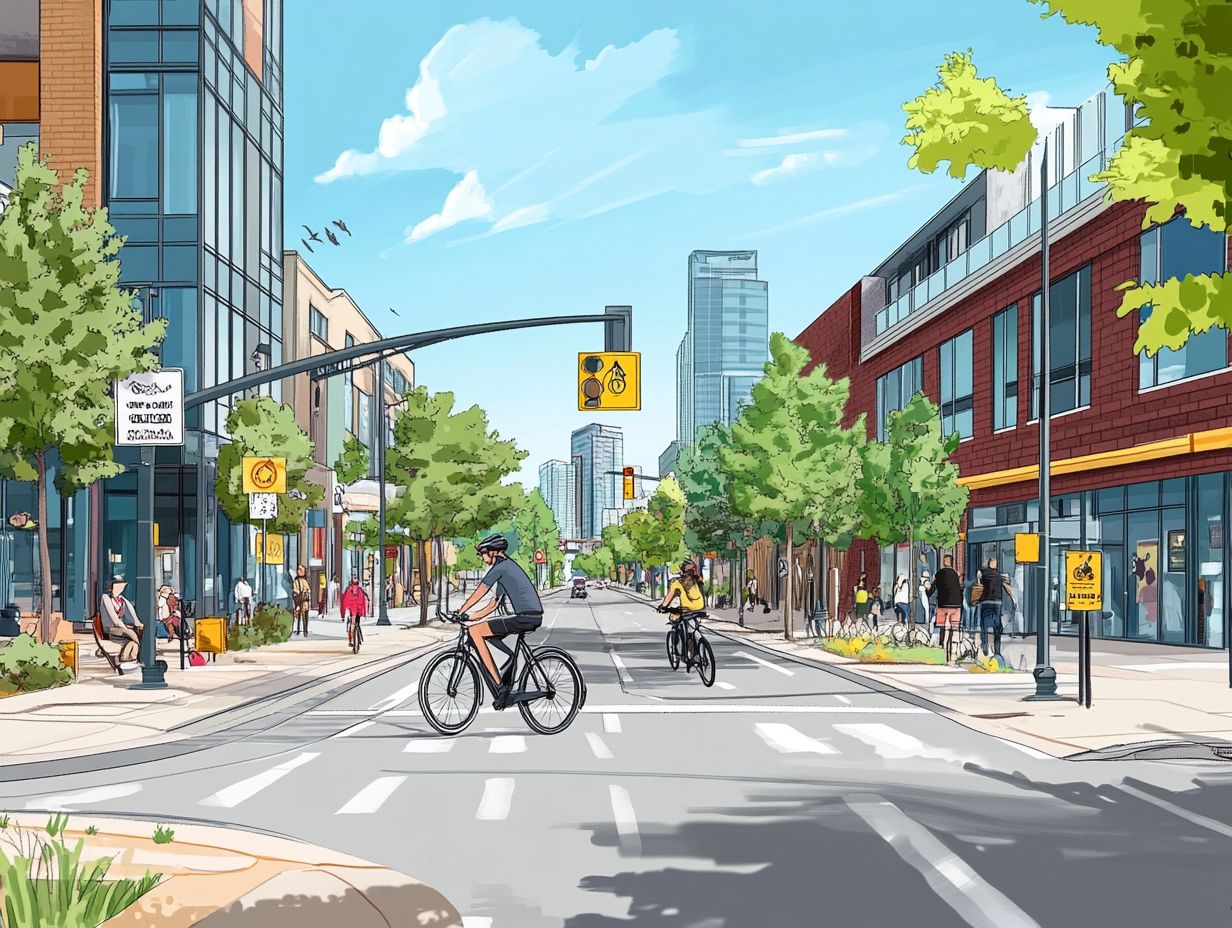
Electric bicycle regulations in urban areas refer to the laws and rules that govern the use of electric bicycles within city limits. These regulations ensure the safety of riders and others on the roads.
What is the difference between electric bicycles and regular bicycles?
Electric bicycles have an added motor that assists with pedaling, while regular bicycles rely solely on human power. This motor allows for easier and faster riding but comes with specific regulations.
To learn more about local regulations or join a local cycling group, get involved and stay informed!
Do electric bicycles need to be registered and licensed in urban areas?
In most urban areas, electric bicycles do not require registration or licensing like regular motor vehicles. However, some cities have local rules that may require registration, so check with your local authorities to stay informed!
Are there age restrictions for riding electric bicycles in urban areas?
Yes, most cities impose age restrictions for riding electric bicycles on public roads. Riders usually must be at least 16 years old, and some cities may also require a driver’s license.
Are there speed limits for electric bicycles in urban areas?
Yes, urban areas often have speed limits for electric bicycles. These limits are generally lower than those for motor vehicles to ensure everyone’s safety on the road.
Do electric bicycles need to follow the same traffic laws as regular bicycles in urban areas?
Yes, electric bicycles must obey the same traffic laws as regular bicycles. This includes stopping at stop signs, following traffic lights, and using designated bike lanes when they are available.

